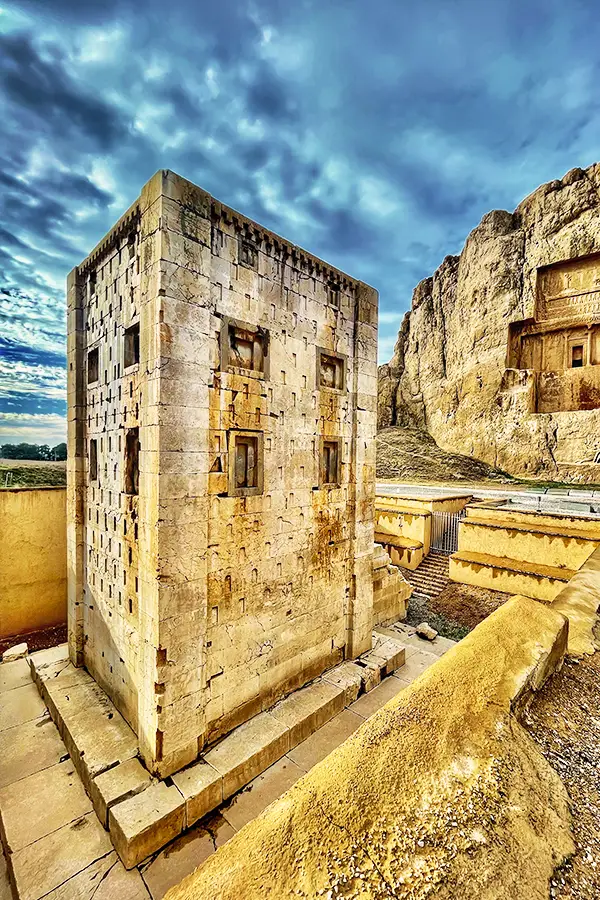
Naqsh-e Rustam Complex
- Royal Tombs at Naqsh-e Rustam
- Tomb of Darius I at Naqsh-e Rustam
- Ka'ba-ye Zartosht at Naqsh-e Rustam
Naqsh-e Rustam is one most significant archaeological sites of Iran. The monuments within this complex date back to the Elamite (3rd millennium BCE), Achaemenid (550–330 BCE), and Sassanid (221–656 CE) periods. This impressive necropolis is located a few kilometres from Persepolis, the capital of the Persian Empire. It was established near the Husain Kuh Cliffs, which were well-suited for carving tombs. Naqsh-e Rustam was regarded as a sacred site in pre-Islamic Iran and served for centuries as the burial ground for ancient Persian kings from the Achaemenid and Sassanid dynasties.
The name of the complex, which in Persian means "Image of Rustam," emerged after the Arab conquest, due to the popular association between the Sassanid kings depicted in the rock reliefs and Rustam, the legendary hero of the Iranian national epic immortalised in Ferdowsi's Shahnameh ("The Book of Kings").
The Naqsh-e Rustam complex features monuments from various stages of Iranian history. The oldest is an Elamite rock relief (3rd millennium – mid-6th century BCE), depicting the goddess Anahita and a king and queen seating on a throne. However, by order of the Sassanid king Bahram II, the relief was partially changed to feature himself and his courtiers. The complex also includes the royal tombs of Darius I, Xerxes I, Artaxerxes I, and Darius II, as well as the square tower known as the Ka'ba-ye Zartosht (Kaaba of Zoroaster).
Royal Tombs at Naqsh-e Rustam
The central attraction of Naqsh-e Rustam is its four tombs, carved into the cliff face at a considerable height above the base of the hills. Only one tomb has been identified, thanks to an inscription above it, as belonging to the Persian king Darius I. Archaeologists believe that the other three tombs are those of Achaemenid kings Xerxes I (Darius's eldest son), Artaxerxes I, and Darius II.
All four tombs are cross-shaped, which has got the site the alternative name "Persian Crosses." In the centre of each cross there is an opening that leads into a chamber where sarcophagi may have been placed. It remains unclear whether the bodies were placed directly into sarcophagi within the tombs or if bones were collected from a Tower of Silence and later buried, following traditional Zoroastrian ritual practices.
A Tower of Silence (or Dakhma) is a circular structure used in the Zoroastrian ritual of exposure of the dead: bodies are placed atop the tower, where carrion birds consume the remains.
The tomb entrances are framed by rectangular elements replicating palace facades, flanked by recessed columns with capitals adorned with double-headed bulls. Above each entrance, a large square bas-relief features 28 bearers, symbolising the nations under Persian rule. Arranged on two levels, like Atlantes, they support a throne platform upon which the king stands. The king, depicted on a pedestal, holds a recurve bow, symbolising authority, and performs a ritual sacrifice before a fire altar beneath an image of Faravahar, the primary symbol of Zoroastrianism.
The fifth tomb remains unfinished. It is believed to have been intended for Artaxerxes III (358–338 BCE) or the last Achaemenid king, Darius III (336–330 BCE). The tombs at Naqsh-e Rustam were plundered after the conquest of the Achaemenid Empire by Alexander the Great.
Beneath the burial chambers there are seven bas-reliefs from the Sassanid period (224–651 CE). The Sassanids, considering themselves worthy successors to the Achaemenids, revived the art of rock reliefs to capture significant historical event.
One relief depicts the coronation of Ardashir I Papakan, the founder of the Sassanid dynasty. Facing each other on horseback there are the king and Ahura Mazda (the supreme deity of Zoroastrianism), who gives Ardashir a ring symbolising legitimate authority, thereby appointing him as the "King of Kings" of the Iranian lands. The horses trample the bodies of their enemies: on one side, the defeated Parthian king Artabanus V, and on the other, Ahriman, the lord of evil, darkness, and death. Other reliefs at Naqsh-e Rustam depict scenes such as the Narseh's coronation, the Sassanid Shahanshah who ruled in the 3rd century.

Tomb of Darius I at Naqsh-e Rustam
The tomb of Darius is carved into the rock face at a height of 20 metres. As previously mentioned, the facade of the tomb resembles a cross. The facade features a bas-relief depicting Darius. He holds a bow in his left hand while raising his right hand in a gesture of greeting. Above the ruler is the winged disc of Ahura Mazda, who blesses Darius and bestows upon him the symbol of authority—the khvarenah ring. The lower part of the bas-relief shows a platform supported by figures representing the nations of the Persian Empire. These figures are intricately carved, with distinct facial features and clothing that highlight their differences.
Inside, the tomb consists of a vestibule and three vaulted chambers. Burial urns, where the remains of Darius I were kept, were carved into the floor.
Ka'ba-ye Zartosht at Naqsh-e Rustam
At the base of the cliffs, opposite the royal tombs, stands a square tower known as the Ka'ba of Zoroaster (Kabeh-ye Zardosht or Ka'ba-ye Zarathustra). Its name refers both to the Ka'ba, the Muslim sanctuary (from the Arabic ka'b, meaning cube), which in Persian culture became a term for any sacred place, and to the prophet Zoroaster, the founder of Zoroastrianism. In Middle Persian, the building is called diz-i nibišt, which means "fortress of sacred texts.".
The Ka'ba of Zoroaster is a square tower located directly opposite the tomb of Darius I. The structure is 11 metres high and 7 metres wide, with an internal chamber measuring 5.3 by 3.7 metres and a staircase leading up.
The exact purpose of the tower remains uncertain. Some scholars believe it was a temple for maintaining the sacred fire. However, the lack of ventilation inside the tower casts doubt on this theory. French historian Jean-Paul Roux, in his book "The History of Iran and the Iranians", suggests that the Ka'ba was not used to maintain the sacred fire but to protect it from natural elements such as rain or strong winds.
Other scholars, such as art historian R. R. Vergazov, considered the Ka'ba a storage for state documents and sacred Zoroastrian texts like the Avesta. Another theory proposes that it served as a temporary tomb for storing bodies before final burial. There is also speculation that the structure functioned as a coronation tower. A similar building exists in Pasargadae, constructed with identical techniques and widely believed to be the tomb of Cyrus the Great, though its true purpose remains unknown.
In 1931, a series of archaeological expeditions at Naqsh-e Rustam were conducted by specialists from the Oriental Institute of the University of Chicago, led by Erich Schmidt..
Today, Naqsh-e Rustam is still standing as a magnificent testament to Iran’s rich heritage, offering a glimpse into the world of ancient Persia.

I want to visit
Naqsh-e Rostam
Visitor Information
- Opening Hours:
- Monday: 08:00 – 18:30
- Tuesday: 08:00 – 18:30
- Wednesday: 08:00 – 18:30
- Thursday: 08:00 – 18:30
- Friday: 08:00 – 18:30
- Saturday: 08:00 – 18:30
- Sunday: 08:00 – 18:30
- Entrance: Paid
- Cash/Credit Card accepted: Cash
- Region: Fars Province
- City: Marvdasht
- Address: Marvdasht. Marvdasht Road
- Phone number: +987143341556
- Is open to public visitors: Yes
Tours featuring a visit to the Naqsh-e Rostam
- GUIDED GROUP TOUR

Guided group tour package
Tehran - Kashan - Abyaneh - Isfahan - Yazd - Persepolis - Shiraz
Tour start dates:
16.09.2025 -21.09.2025
05.10.2025 -12.10.2025
19.10.2025 -26.10.2025
02.11.2025 -09.11.2025
16.11.2025 -23.11.2025
30.11.2025 -07.12.2025
SGL € 1 310 per person
DBL € 1 140 per person
- GUIDED GROUP TOUR

Guided group tour pacakge
Tehran - Kashan - Abyaneh village - Isfahan - Yazd - Persepolis - Shiraz - Bandar Abbas - Keshm - Hormuz Island - Hengam Islands
Tour start dates:
16.09.2025 -27.09.2025
05.10.2025 -16.10.2025
19.10.2025 -30.10.2025
02.11.2025 -13.11.2025
16.11.2025 -27.11.2025
30.11.2025 -11.12.2025
SNG € 1 790 per person
DBL € 1 570 per person
- GUIDED PRIVATE TOUR

Private sightseeing tour to Iran
Tehran - Hamadan - Ali-Sadr - Behistun Inscription - Kermanshah - Taq-e Bostan - Shiraz - Persepolis - Yazd - Isfahan - Matinabad - Abyaneh - Kashan
Tour start dates:
ANY DATE
SGL € 5 400 per person
DBL € 3 300 per person












